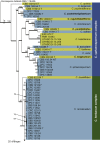Common but different: The expanding realm of Cladosporium
- PMID: 26955200
- PMCID: PMC4774271
- DOI: 10.1016/j.simyco.2015.10.001
Common but different: The expanding realm of Cladosporium
Abstract
The genus Cladosporium (Cladosporiaceae, Dothideomycetes), which represents one of the largest genera of dematiaceous hyphomycetes, has been intensively investigated during the past decade. In the process, three major species complexes (C. cladosporioides, C. herbarum and C. sphaerospermum) were resolved based on morphology and DNA phylogeny, and a monographic revision of the genus (s. lat.) published reflecting the current taxonomic status quo. In the present study a further 19 new species are described based on phylogenetic characters (nuclear ribosomal RNA gene operon, including the internal transcribed spacer regions ITS1 and ITS2, as well as partial actin and translation elongation factor 1-α gene sequences) and morphological differences. For a selection of the species with ornamented conidia, scanning electron microscopic photos were prepared to illustrate the different types of surface ornamentation. Surprisingly, during this study Cladosporium ramotenellum was found to be a quite common saprobic species, being widely distributed and occurring on various substrates. Therefore, an emended species description is provided. Furthermore, the host range and distribution data for several previously described species are also expanded.
Keywords: C. aggregatocicatricatum Bensch, Crous & U. Braun; C. angustiherbarum Bensch, Crous & U. Braun; C. angustiterminale Bensch, Crous & U. Braun; C. austroafricanum Bensch, Crous & U. Braun; C. austrohemisphaericum Bensch, Crous & U. Braun; C. ipereniae Bensch, Crous & U. Braun; C. limoniforme Bensch, Crous & U. Braun; C. longicatenatum Bensch, Crous & U. Braun; C. longissimum Bensch, Crous & U. Braun; C. montecillanum Bensch, Crous & U. Braun; C. parapenidielloides Bensch, Crous & U. Braun; C. penidielloides Bensch, Crous & U. Braun; C. pseudochalastosporoides Bensch, Crous & U. Braun; C. puyae Bensch, Crous & U. Braun; C. rhusicola Bensch, Crous & U. Braun; C. ruguloflabelliforme Bensch, Crous & U. Braun; C. rugulovarians Bensch, Crous & U. Braun; C. versiforme Bensch, Crous & U. Braun; Cladosporiaceae; Cladosporium aciculare Bensch, Crous & U. Braun; Emendation; Phylogeny; Taxonomic novelties; Taxonomy.
Figures








































References
-
- Allescher A. Einige weniger bekannte Pilze aus den Gewächshäusern des Kgl. Botan. Gartens in München. Hedwigia. 1895;34:215–221.
-
- Aptroot A. Mycosphaerella and its anamorphs: 2. Conspectus of Mycosphaerella. CBS Biodiversity Series. 2006;5:1–231.
-
- Braun U., Crous P.W., Dugan F.M. Phylogeny and taxonomy of cladosporium-like hyphomycetes, including Davidiella gen. nov., the teleomorph of Cladosporium s.str. Mycological Progress. 2003;2(1):3–18.
LinkOut - more resources
Full Text Sources
Other Literature Sources
Research Materials
Miscellaneous
